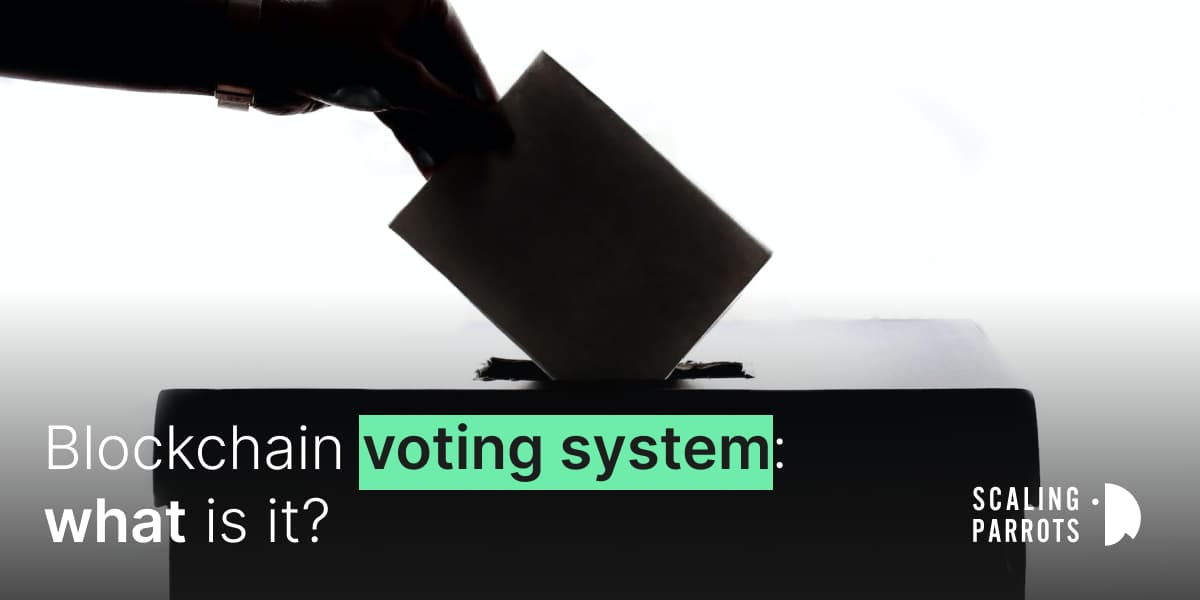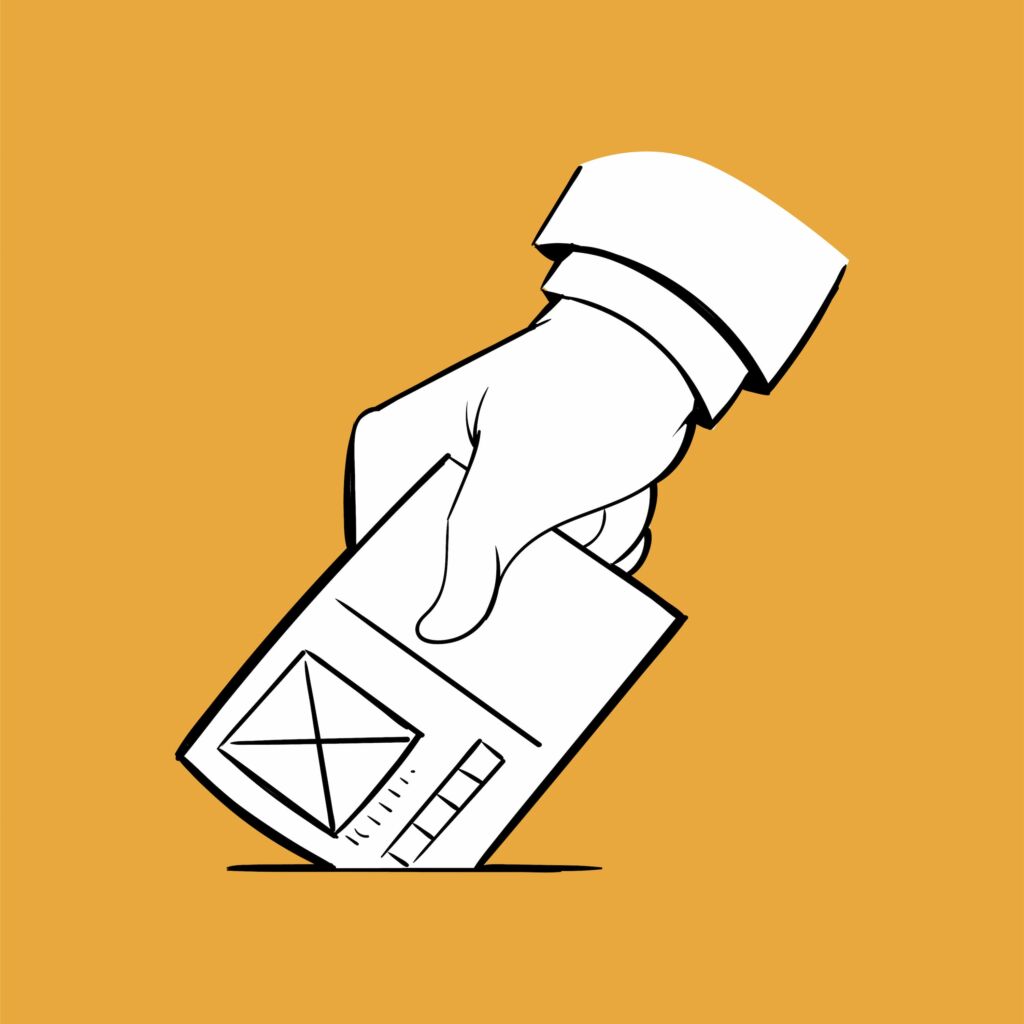
Blockchain is a technology that is quickly gaining momentum in the industrial era. It is widely utilized in supply chain management systems, healthcare, payments, business, voting systems, and other areas because of its high security and transparency guarantees.
Despite the digitalization of many areas of modern life, elections are still generally performed using “analog” means, i.e., old-fashioned paper ballots.
For numerous years, we have heard about a return to ancient voting procedures, which are unavoidably bound to evolve with a particular gain of time and economic resources. A more efficient voting method is also speedier and can handle a more significant number of voters, which may support the development of a more robust democratic sense.
A more advanced voting system may give birth to an ecosystem of dedicated services, such as voter engagement at polling places or the ability to vote without requiring a supervisor. It should also be noted that complex technologies might be avoided by using smartphones or tablets currently in possession of voters.
But how can these complex technologies be avoided when blockchain is implemented in voting systems? How exactly does the blockchain voting system work? This article will help answer that question.
But before we see what a blockchain voting system is, let’s briefly overview what blockchain means and how it works.
What is Blockchain?
Blockchain is a DLT (Distributed Ledger Technologies) distributed computer system that allows the sharing and management of a specific distributed ledger, called “blockchain.” Blockchain makes it easier to track and record transactions in a business network, where transactions between various subjects using the same technology are transcribed.
Blockchain register has a block structure in which each block is chained to a preceding one. The system of the register has given the technology its name, which is always referenced with the initial in capital letters.
With strong encryption, consensus, and sharing procedures, blockchain ensures the security of transactions and ledgers.
Satoshi Nakamoto devised a Blockchain in 2008 to be used as a log for public transactions in the cryptocurrency Bitcoin. The Blockchain development for Bitcoin enabled it to be the first digital money to tackle the problem of double spending without the requirement for a trusted authority or a central server. The Bitcoin concept has inspired other apps.
How does Blockchain work?
The blockchain is a digital ledger that records all transactions made in a network. It is a decentralized system, meaning a single authority does not control it.
It is instead managed by a poll of computers, each of which has a copy of the ledger. When a transaction is made, it is verified by the network and then recorded in the blockchain. This process is known as consensus.
The blockchain is transparent, meaning anyone can see all the transactions made.
It is, nonetheless, safe since each transaction is encrypted and can only be decoded with the private key of the person who initiated it.
The blockchain can record any type of transaction, such as financial transactions, contracts, or voting. It has the potential to transform numerous sectors, making them more efficient and safe.
Having seen what blockchain means and how it works, let’s now discuss what the blockchain voting system means.
What is a Blockchain voting system?
To vote digitally, voters utilize electronic equipment such as voting machines or an internet browser. We may refer to e-voting when using a polling machine and i-voting when using a web browser.
The blockchain network can monitor votes, count votes, and ensure the integrity of the outcome. Blockchain technology assures that no one votes twice, that only qualified voters have the opportunity to vote, and that votes cannot be tampered with.
With this in mind, let’s see what the basic principles of voting are and how blockchain can be implemented in voting.
Basic principles of voting
According to the Equal Justice Foundation, the six voting principles are as follows.
- Secret Ballot: Your vote is kept private. Nobody should be able to trace your vote back to your ethnicity, gender, age, or personal characteristics.
- One man, one vote: Every voter votes only once, and the voting system must be able to reconcile the total number of votes to the total number of voters and those who did not vote.
- Voter eligibility: Only qualified voters may vote.
- Transparency: The voting process is set, the rules are clearly defined, voters are aware of them, and it can bear public examination.
- Votes are recorded and counted accurately: Vote counting is constant. The rules are set in stone. Vote tallies are auditable.
- Reliability requires that the voting method be accurate and verifiable. Safeguards are in place to avoid fraud, accidents, and security breaches.

How does the Blockchain voting system work?
The governing authority must first readily permit and install a blockchain-based voting system and ensure that individuals understand the ballot-casting method step by step.
For blockchain voting to function well, there must be a means to verify that the voters are citizens of the nation in question.
This can be challenging since voting on a decentralized network requires reliance on a centralized authority for citizenship verification. However, identification verification is critical since it prevents people from voting more than once.
In particular, how does a vote take place on the blockchain? Consider the system established by BELEM, a Station F start-up dedicated to blockchain, for the political organization “We Citizens”.
Based on the Ethereum blockchain, this voting method was utilized in 2016 as part of the movement’s territorial delegate elections. During this trial, each voter received an email with a web link describing Belem co-founders Romain Rouphael and Côme Jean Jarry in a blog post. The encrypted link will be transmitted via a specific application or other methods.
This vote database is open to all voters. On this page, voters were prompted to select one of two options. Once the vote was registered, each participant received an email confirming the vote’s registration on the blockchain. Voters may therefore check that their vote was counted in the same manner crypto users can verify that their transactions were completed.
Not surprisingly, every vote recorded is 100% anonymous. The only data displayed in the database are the time and date of the “transaction” and the participant’s choice. As with the case of cryptocurrency transfers, the vote has an identification number when added to a block.
Once the vote has been registered, it cannot be deleted or changed. Each vote is indeed linked to the previous one. This is the basis of blockchain. The distributed ledger, therefore, keeps an immutable, transparent and tamper-proof record of all votes. The election results cannot, therefore, be changed.
BELEM has put up a smart contract to count the votes. This smart contract was established to track and calculate the number of votes cast for each proposed alternative. The BELEM technique is easily adaptable to elections using electronic vote boxes.
How does a Blockchain-based voter cast a vote?
Blockchain voting works in the same way that traditional voting does. The following is the general procedure:
- A voter obtains the appropriate blockchain voting application, registers, and verifies their citizenship.
- The blockchain uses the voter’s public key to record and encrypt its credentials on its network.
- On the network, a ballot token is placed into the voter’s wallet.
- To vote, the voter transfers the token to the address or wallet associated with the candidate or party for which they desire to vote. Each token equals one vote.
- To select the winner, counting staff members examine and compare the number of tokens in the addresses.
Benefits of Blockchain voting system
The goal of blockchain voting is to give voters a variety of benefits, including anonymity. Voters may use blockchain technology to remain anonymous while selecting and voting for any candidate.
Second, for simplicity’s sake. People may vote from the comfort of their own homes or companies because registration and voting usually are done online, eliminating long lineups.
Finally, due to the immutability of Blockchain technology, it provides a trustworthy voting system. Users may be confident that their votes can not be altered without their permission.
Examples of Blockchain voting systems
In recent years, small and large-scale experiments have multiplied in several world regions. In 2018, the municipality of Zug (Switzerland) relied on blockchain in a municipal vote located in the middle of the famous crypto-valley.
The town says that the experiment was a real success. However, it should be noted that this pilot test involves only 72 voters. At the same scale, NASDAQ has used blockchain technology to facilitate shareholder voting for certain companies.
More recently, Moscow, the capital of Russia, allowed 65000 residents to vote via blockchain in local elections. Faced with the success of this test, Russia wants to expand the use of blockchain.
From 2021, voting via blockchain was used for parliamentary elections, including those of the Duma. Unfortunately, an investigation by the Russian media Meduza shows that the system developed with Kaspersky still makes it possible to find the identity of each of the voters despite the warnings of Pierrick Gaudry in 2019.
Sierra Leone was the first country to conduct an election using a blockchain-based system. Blockchain technology was used to record anonymous votes and election results.
The Japanese city of Tsukuba also integrated blockchain technology into a voting system to produce a fully transparent and reliable voting system.

Advantages and disadvantages of Blockchain voting system
Advantages
- Error reduction: In analog voting, voters must rely on poll workers, counting personnel, and independent observers to handle and count ballots accurately. Errors can occur during human or mechanical counting, leading votes to be over or under-reported inadvertently. However, under a blockchain-based voting system, citizens may monitor their votes, which include no personally identifying information, and verify their voting records, which are permanently stored on the network.
- Convenience and accessibility: Blockchain voting allows individuals to vote from their computers or phones rather than going to a polling place. This simplification may help to counteract voter indifference and increase voter turnout. It also helps to avoid delays and the potential loss of ballots cast by individuals with impairments.
- Efficiency: Current voting systems rely on manual and mechanical counting, which consumes time and resources. No polling infrastructure or workers is required, resulting in a less expensive, faster, and more efficient method of announcing the results. Organizers can view a candidate’s or party’s total votes by looking at the balance of an address.
- Prevention of election fraud and rigging: According to one expert, blockchain’s decentralized network can dissuade electoral fraud since creating false votes on the network would be too computationally costly. An academic study shows that transparent voting records reduce the possibility of a manipulated election by allowing voters to verify their ballots using their personal data on the network.
Disadvantages
- Because the ledger is public, a voter may show a third party where they transferred their money or tokens as proof of how they voted. This action enables the third party to purchase votes or persuade voters to vote in a specific manner.
- Denial-of-service attacks: During the election period, attackers may attempt to interrupt network connectivity to prevent ballots from being cast and validated on time. Attackers with significant funds can delay validation by flooding the blockchain network with transactions. This measure would increase transaction costs for voters while also lengthening transaction completion time.
- Key management: Blockchain technology is highly secure. However, suppose the private keys and passcodes that ensure the security of user accounts and wallets are lost or fall into the wrong hands. In that case, they might constitute a point of vulnerability. When a voter’s private key is compromised, they cannot vote. An attacker can vote in the place of a voter if they have the voter’s private key. This type of action is prevalent in the crypto realm. Because of inadequate private key management, several users and bitcoin exchanges have lost private keys. This is unavoidable since public key cryptography is a fundamental component of blockchain technology.
Conclusion
If done effectively, blockchain voting can increase turnout while making elections more accessible and transparent. After identification verification, citizens may vote using personal computers or mobile phones.
The network readily validates vote counting in real-time, making voting records easily verifiable. Blockchain voting saves time and money while paving the way for direct democracy. Blockchain voting, on the other hand, is still in its early stages.
Since votes cast via a blockchain-based voting system are not totally anonymous, as voters may use transaction data to establish how they voted, this sort of voting system is also subject to denial-of-service assaults, which prevent voters from voting on time.
With the risks of significantly poor key management and catastrophic failures, blockchain voting has a long way to go before being utilized globally.
See you soon,
Scaling Parrots
